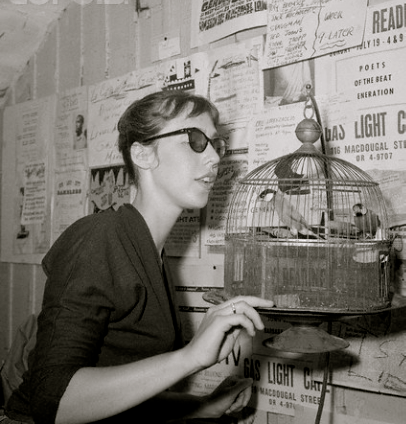A Review of Your Attraction to Sharp Machines by Matthew Mahaney
 Your Attraction to Sharp Machines
Your Attraction to Sharp Machines
by Matthew Mahaney
BatCat Press, May 2013
53 pages / $20 Buy from BatCat Press
A woman from the audience asks: ‘Why are there so few women on this panel? Why are there so few women in this whole week’s program? Why were there so few women among the Beat writers?’ and [Gregory] Corso, suddenly utterly serious, leans forward and says: “There were women, they were there, I knew them, their families put them in institutions, they were given electric shock. In the ’50s if you were male you could be a rebel, but if you were female your families had you locked up. There were cases, I knew them, someday someone will write about them.”
—from Stephen Scobie’s account of the Naropa Institute tribute to Allen Ginsberg, July 1994
“her exhalation
tion”
—Jon Woodward, “Huge Dragonflies,” Uncanny Valley
The back of Matthew Mahaney’s book, Your Attraction to Sharp Machines (AMAZINGLY assembled by hands at BatCat Press) is a silver and black Rorschach image (unique to this copy, #48 of 75) spread across a burlap-ish fabric. I stare and decide it looks like an insect head coming towards me. I think of what it means that this is the shape I chose to chisel the blob into, that this is what this mutable part emerging from the ether is to me. A PhD student is sharing the severely air conditioned portion of the TA office with me. He squints at it, moving around his glasses for a second, and says, “Isn’t it duck feet?” I look at it again and shrug.
E.T.A. Hoffman’s famous short story, “The Sandman,” is built mostly by letters sent between disoriented characters. The letters all dizzily revolve around the horror of attempting to see WHAT and WHO thrives on not being seen or perceived beyond a modestly eerie feeling that “something is off” (the Bogey-men / the Sandman / cyborgs / automatons). Nathaniel, the main character, can’t address his correspondence to the right person, he can’t understand (through his telescope) that he’s entertaining cheating on his fiancee, Clara, with a doll1 (untouchably named Olimpia), and he is haunted by either a man or a male figure of his imagination (the Sandman), who may be stealing the eyes of children at night and selling expensive / haunted Italian eyewear during the day. It is a story about the kickback / the recoil that occurs when there is an un-trusting of the senses / your instincts and their skill set. (“You’re only human,” someone says, to comfort you when you get it wrong.) It is a story that makes us wonder about what our criteria for a human being IS exactly (particularly when we’re talking about women). Most importantly, Hoffman’s disturbing tale questions the confidence we have our in our ability to recognize the difference between person and our most ancient illusions and our newest machines as they meet inside unfolding human events.2
Something I’m getting at is that “The Sandman” plays into a very important part of poetry (and Mahaney’s book): how quickly things can become de-familiarized and what can and does happen to a piece of consciousness when it experiences or expresses that (in the real world and in the more malleable and forgiving forestworld of the ‘poem”).

A USEFUL GRAPH // The Illustrated Uncanny Valley
Poetry knows, in deeper oceans than most forms of writing, the pain that is inevitably linked, both to seeing and to articulating what has been seen. An unnamed narrator of “The Sandman” comes out between the letters to say this on the matter:
When it becomes difficult or overwhelming to decipher and decode what and who is happening in front of you through bites of language, the consequences are mostly Innocuous with a capital I until they aren’t. (Poetry is always potentially toying with this line. Yes, there are birds in my throat. Sometimes I am amazed I do not find actual feathers in my toothbrush when I brush at night.) Towards the end of Hoffman’s story, when Nathaniel suddenly sees one of Olimpia’s eyes rolling around the floor like somebody’s dropped blueberry, he starts trying to kill people until he’s dragged off to an asylum.

Nathaniel’s abandoned, but his decidedly more rational fiancee, Clara, probably goes on to become one of those Women Laughing Alone With Salad.
Serious question. Do you, reader or writer or person with an imagination prone to break its bridle and every sensitive bone in your body, wonder if you would have been placed in some kind of institution (military (if you are male), mental, marriage, sanitorium) were it not that many years ago? I really do. Have you read Kate Zambreno’s Heroines? Zambreno recounts how a number of writers’ talented and vivacious wives, girlfriends, and muses are locked up in various institutions with the same thought you’d grant a rumpled dinner napkin. Christian Hawkey’s Ventrakl? Both George Trakl and his sister, Grete, were in and out of various institutions for their mental instabilities. Trakl’s difficulties were heavily exacerbated by his WWI service and substance addiction. One of the women Gregory Corso is talking about is Elise Cowen, a close friend and ex-lover of Allen Ginsberg who was most certainly writing during the Beat era. When I right click a photo of Corso to save it, the computer lets me know that the photo has simply been named, “beatgirl.png.” I make a face. No doubt any neon smile of a weatherman would predict bad things for me in a different time and place. The last part of what Corso says (In 1994!) should distress more of us. “Someday someone will write about them.”

Elise Cowen
August 5th, 2013 / 11:00 am
